El
Corazon de Cuba
Educational Program
Santa Clara
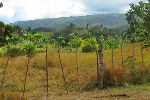
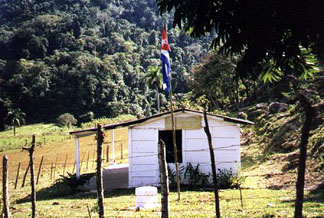 As you
descend down the north slope of the mountains the green become less intense, the
agriculture changes and the temperature warms.
As you
descend down the north slope of the mountains the green become less intense, the
agriculture changes and the temperature warms. 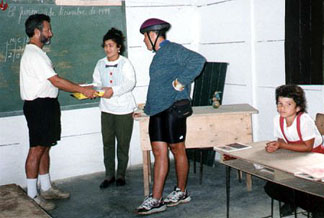
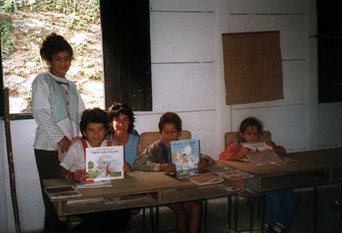 Almost randomly, this was
the morning we
selected to find a rural school. We stopped at a one-room school, with one teacher and
less than a half dozen students. Along with learning something about how the school works
and education in Cuba we left some gifts, including books in Spanish, pencils, paper, an inflatable globe and some
other supplies. Virtually all Cubans go to school and the literacy, rate at 95%, is the
envy of Latin America.
Almost randomly, this was
the morning we
selected to find a rural school. We stopped at a one-room school, with one teacher and
less than a half dozen students. Along with learning something about how the school works
and education in Cuba we left some gifts, including books in Spanish, pencils, paper, an inflatable globe and some
other supplies. Virtually all Cubans go to school and the literacy, rate at 95%, is the
envy of Latin America.
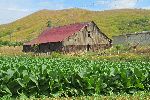
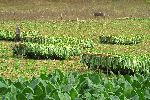 A
dryer warmer climate in Cuba means tobacco growing. When the tobacco leaf is
mature it is picked bunch an draped over poles. The poles are laid across
sleds, which are hauled to the barn by ox. In the barn the poles are hung on
scaffolding that reach floor to ceiling. There the leaf dries slow, and
hopefully remains soft and pliable.
A
dryer warmer climate in Cuba means tobacco growing. When the tobacco leaf is
mature it is picked bunch an draped over poles. The poles are laid across
sleds, which are hauled to the barn by ox. In the barn the poles are hung on
scaffolding that reach floor to ceiling. There the leaf dries slow, and
hopefully remains soft and pliable.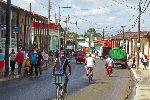
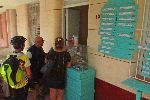 Manicaragua
is a seemingly prosperous town in the middle of an agricultural region. It is
hard to know the whole picker. There were stores and people out on the streets.
One street has been configured as a pedestrian mall. Most building seem to be in
good repair, and there were a variety of vehicles on the roads, though they were
still out numbered by pedestrians. But it is hard to find a restaurant here. At
least in 2004, Manicaragua and Trinidad had about the same population, but they
are not equal in the eatery census.
Manicaragua
is a seemingly prosperous town in the middle of an agricultural region. It is
hard to know the whole picker. There were stores and people out on the streets.
One street has been configured as a pedestrian mall. Most building seem to be in
good repair, and there were a variety of vehicles on the roads, though they were
still out numbered by pedestrians. But it is hard to find a restaurant here. At
least in 2004, Manicaragua and Trinidad had about the same population, but they
are not equal in the eatery census.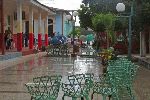
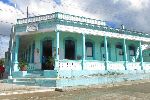
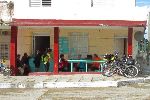
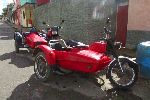
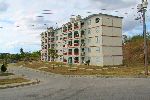
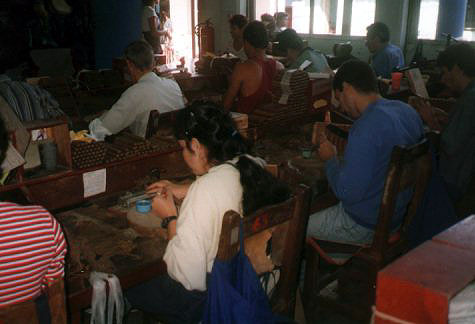
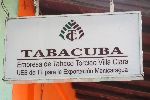
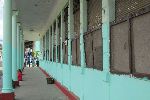 And, cigars mean cigar factories. Cigar factories are widely
scattered in Cuba; we visited one in Manicaragua. Cigars are made in three steps, first
the inside is rolled, which i then pressed, and then the outside finishing leaves are put on.
The work looks very boring, but the workers seemed relaxed and good
natured. A good cigar roller is said to be one of the best paid workers in
Cuba. To make the job interesting and pass the time, readers come in and read the
newspaper and books. Cigar workers also are said to be some of the best informed and
"most well read" in Cuba.
And, cigars mean cigar factories. Cigar factories are widely
scattered in Cuba; we visited one in Manicaragua. Cigars are made in three steps, first
the inside is rolled, which i then pressed, and then the outside finishing leaves are put on.
The work looks very boring, but the workers seemed relaxed and good
natured. A good cigar roller is said to be one of the best paid workers in
Cuba. To make the job interesting and pass the time, readers come in and read the
newspaper and books. Cigar workers also are said to be some of the best informed and
"most well read" in Cuba.
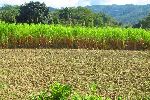
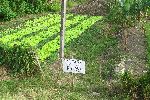
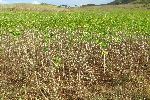 The
elevation and climate keep changing. A little lower, a little warmer and a
little drier and the crops change. In this section sugar cane (left) is the
dominate cash crop. There was a large field of yucca (cassava) (right), which is
packed with carbohydrates. The salad garden (far right) has a sign on the fence
that reads, "Siempre con Fidel", "always with Fidel".
The
elevation and climate keep changing. A little lower, a little warmer and a
little drier and the crops change. In this section sugar cane (left) is the
dominate cash crop. There was a large field of yucca (cassava) (right), which is
packed with carbohydrates. The salad garden (far right) has a sign on the fence
that reads, "Siempre con Fidel", "always with Fidel".
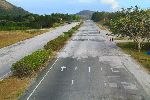
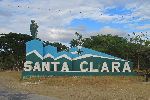 Near Santa Clara
we passed the autopista again. Again the road was almost empty, and people stood
along the edge hoping for a lift.
Near Santa Clara
we passed the autopista again. Again the road was almost empty, and people stood
along the edge hoping for a lift.The sign making the town features an Argentinean who spent less than a week here in December 1958. The irony of that is in comparison to Marta Abreu, a woman born in Santa Clara, and renowned for her decades of charity work, civic involvement, anti-colonialism and philanthropy in Santa Clara.
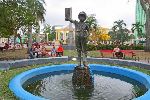
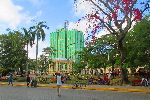
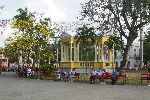 Parque
Leoncio Vidal, former known as Plaza Mayor and Plaza Central, takes up an entire
city block. The park honors Leoncio Vidal, the hero who died fighting against
Spanish forces, in this very location.
Parque
Leoncio Vidal, former known as Plaza Mayor and Plaza Central, takes up an entire
city block. The park honors Leoncio Vidal, the hero who died fighting against
Spanish forces, in this very location.In the center if the park is the Glorieta gazebo in the center of the park, erected in 1911. Nearby is “el niño de la bota” (The Boy with the Leaking Boot), one of the symbols of the city. There are dozens of variations of this statue around the world. Its origins are unclear.
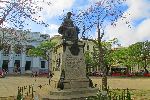
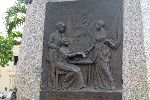
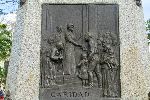
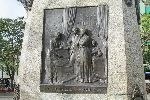 At
the south end of the park is a statue of the beloved patron, Marta Abreu de
Estevez (1845-1909). The inscriptions uses the words "august", and "sublime
incarnation of charity and patriotism." The relief depict her work with civic
progress, charity and patriotism. Some of the projects her philanthropy
underwrote are the theater, old peoples' s home, home for poor and homeless,
school for black children, weather station and its instruments, firemen's
quarters, city power plant, and the train station, among others. She support the
independence movement, against Spanish colonialism, to the tune of what would be
over a million US dollars, in today's value. There is a time-capsule in the base
of the stature, to be opened by future generations.
At
the south end of the park is a statue of the beloved patron, Marta Abreu de
Estevez (1845-1909). The inscriptions uses the words "august", and "sublime
incarnation of charity and patriotism." The relief depict her work with civic
progress, charity and patriotism. Some of the projects her philanthropy
underwrote are the theater, old peoples' s home, home for poor and homeless,
school for black children, weather station and its instruments, firemen's
quarters, city power plant, and the train station, among others. She support the
independence movement, against Spanish colonialism, to the tune of what would be
over a million US dollars, in today's value. There is a time-capsule in the base
of the stature, to be opened by future generations.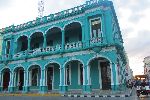
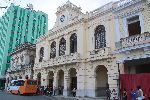
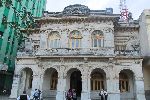
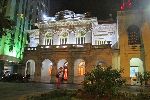
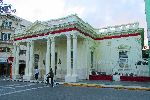
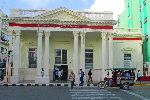 The
eclectic assembly of buildings (it is hard to label all of the architectural
styles) on the west side of the plaza
are; Cultural House, Hotel Central (formerly a city hall, and under renovation
so not photographed), Emisora Radial CMHW, an ornate building of unknown purpose (shown day and
night), the often maligned international-style, Hotel Santa Clara Libre (green high-rise box,
built before the Revolution, and formerly the Santa Clara Hilton) and
colonial-style BANDEC
(a bank at the corner)
The
eclectic assembly of buildings (it is hard to label all of the architectural
styles) on the west side of the plaza
are; Cultural House, Hotel Central (formerly a city hall, and under renovation
so not photographed), Emisora Radial CMHW, an ornate building of unknown purpose (shown day and
night), the often maligned international-style, Hotel Santa Clara Libre (green high-rise box,
built before the Revolution, and formerly the Santa Clara Hilton) and
colonial-style BANDEC
(a bank at the corner)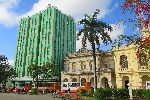
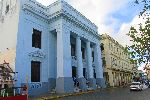
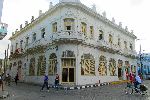 On the south side of the park is a
cubist, neo-classic design high
school (left).
On the south side of the park is a
cubist, neo-classic design high
school (left).Continuing around, another pleasing colonial-era building is at the southeast corner (right).
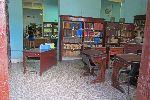
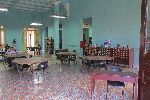
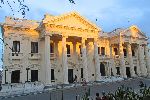
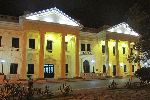
Probably the most elegant building facing the park, day or night, takes up much of the east side. It is truer classical architecture style. It is also referred to as a former City Hall, but it is now serves as the José Martí Library.
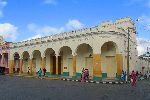
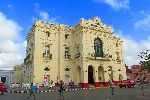 At
the northeast corner of the park is the Museum of Decorative Arts, which houses
one of the biggest collections of colonial decorative arts in the country.
At
the northeast corner of the park is the Museum of Decorative Arts, which houses
one of the biggest collections of colonial decorative arts in the country.At the west end of the block is the Teatro La Caridad (Theater of Charity, built by Marta Abreu).
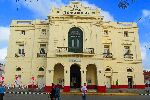
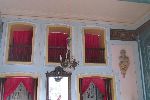 On
one night when we
were in Santa Clara, we lucked into the chance to see the Habana Ballet Company perform at
the Teatro La Caridad. It, along with the theaters in Matanzas and
Cienfuego, are considered to be the great historic theaters in Cuba.
On
one night when we
were in Santa Clara, we lucked into the chance to see the Habana Ballet Company perform at
the Teatro La Caridad. It, along with the theaters in Matanzas and
Cienfuego, are considered to be the great historic theaters in Cuba.At four dollars, just to see the inside of the theater was worth the price of admission. The ballet was a bonus.
The ballet was called "La Habana Valdes". The story line was about a woman forced to marry one man but who was in love with another. She tries to kill her husband, but the knife is taken away and is later used to kill the man she loves. Her lover dies slowly and very passionately. Far more captivating than the story line was the choreography and music. The music which was drawn from every Cuban style and then some. Beside salsa, son, calypso, Afro-Cuban and rumba, there was flamenco, classical and jazz, depending upon the nature of the scene. A particularly memorable dominos gambling scene, which symbolized the struggle between the two men, was highly rhythmic and all created by the dancers as the betting and playing went from side to side and became increasingly faster and more intense. The fight scene between the two male rivals was a foot stomping duo flamenco style. There is a lot of humor and very colorful costumes like in a Brazilian Carnival-like scene. Another tremendous scene featured a street sweeper dancing with her broom and 4 other men with canes, all stomping their feet in beautiful rhythms. The bullfight scene reminded one of our group members of "Carmen". We all left very pleased.
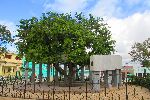
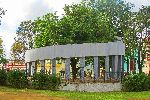
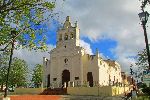 The
Iglesia del Carmen marks the location where the founders of Ville Clara
(initial name of Santa Clara) celebrated their first mass, on the 15 of
July, 1689. Adjacent to the church is a circular monument with an elevated
wall, that wraps around a tree. On the wall are inscribed the names of all
of the founding families of the city.
The
Iglesia del Carmen marks the location where the founders of Ville Clara
(initial name of Santa Clara) celebrated their first mass, on the 15 of
July, 1689. Adjacent to the church is a circular monument with an elevated
wall, that wraps around a tree. On the wall are inscribed the names of all
of the founding families of the city.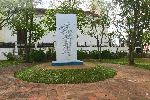 Captain
Roberto Rodríguez (known as "El Vaquerito") is honor with a memorial in the
garden of Iglesia del Carmen. He joined the revolution in the Sierra Maestra.
He is described as a short, strong, smart and dedicated fighter. Because of
these attributes, he was part of a "suicide squad", in the army of Che
Guevara. As they cross Cuba, Rodriguez's squad fought a number of successful
battles. During the battle for Santa Clara, on December 30, 1958,
Guevara dispatched his "suicide squad", then under the leadership 18-year
old Captain Rodriguez, to capture a government position on a hill, using
hand grenades. Though Rodriguez perished in the battle, his bravery became
legendary. The government troops eventually abandon their position, and
Rodriguez's troops carried the day.
Captain
Roberto Rodríguez (known as "El Vaquerito") is honor with a memorial in the
garden of Iglesia del Carmen. He joined the revolution in the Sierra Maestra.
He is described as a short, strong, smart and dedicated fighter. Because of
these attributes, he was part of a "suicide squad", in the army of Che
Guevara. As they cross Cuba, Rodriguez's squad fought a number of successful
battles. During the battle for Santa Clara, on December 30, 1958,
Guevara dispatched his "suicide squad", then under the leadership 18-year
old Captain Rodriguez, to capture a government position on a hill, using
hand grenades. Though Rodriguez perished in the battle, his bravery became
legendary. The government troops eventually abandon their position, and
Rodriguez's troops carried the day.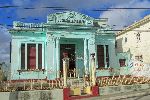
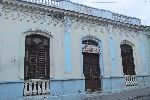
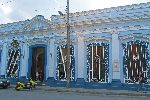
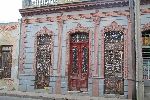
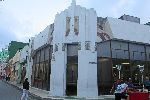
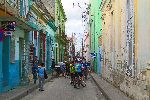
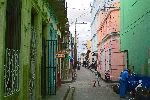
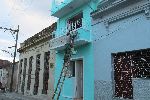 Build
color doesn't rise to the pitch that it is in Trinidad, but there are a variety
of pink, green, blue and yellow buildings in older Santa Clara.
Build
color doesn't rise to the pitch that it is in Trinidad, but there are a variety
of pink, green, blue and yellow buildings in older Santa Clara.
One building was being painted as I passed (right), and when I retuned a half-hour later the job was finished.
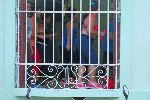 Walking
down the street at about 6pm, the music pouring through the window grating, out
into the street. Behind them, the crowd of bodies doing their aerobics class
provide a good illustration of the role of private
enterprise in today's Cuba - since Raul assumed the presidency. There were
government gyms before this, but people complained that there was little
equipment and it was old. The hours were 8am-noon and 1pm-5pm, when most people
were working. The private gyms are open until midnight, have a variety of new
equipment, and offer a wider variety of programs. Of course they are also
more crowded.
Walking
down the street at about 6pm, the music pouring through the window grating, out
into the street. Behind them, the crowd of bodies doing their aerobics class
provide a good illustration of the role of private
enterprise in today's Cuba - since Raul assumed the presidency. There were
government gyms before this, but people complained that there was little
equipment and it was old. The hours were 8am-noon and 1pm-5pm, when most people
were working. The private gyms are open until midnight, have a variety of new
equipment, and offer a wider variety of programs. Of course they are also
more crowded.
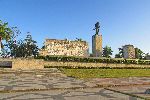
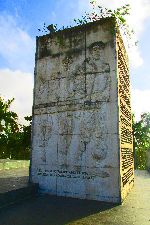
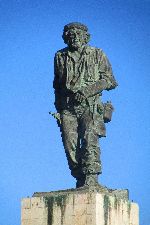
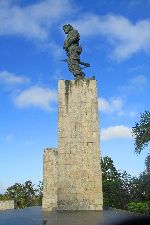
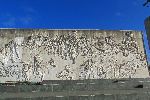 The
is some irony, that on the edge of Santa Clara is a plaza dedicated primarily to Che
Guevara - a man who loathed private enterprise or at least capitalism. The
complex for Che houses a memorial, monument and museum. The monuments is
fairly typical of a war monument. It focuses on a pedestal with a statue of Che in
fatigues and carrying an assault rifle.
The
is some irony, that on the edge of Santa Clara is a plaza dedicated primarily to Che
Guevara - a man who loathed private enterprise or at least capitalism. The
complex for Che houses a memorial, monument and museum. The monuments is
fairly typical of a war monument. It focuses on a pedestal with a statue of Che in
fatigues and carrying an assault rifle.
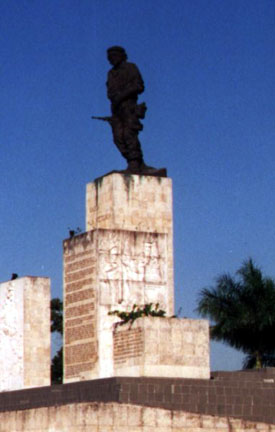
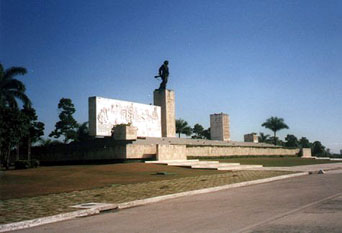 The memorial is much more significant.
It
is subterranean, like the caves of the bases in the Sierra Maestra. Besides
Che, it
is a memorial to the other members of the core group that spent the early days of the
revolution in the Sierra Maestra with Fidel, Cienfuego and Che. In keeping with the
revolutions philosophy of a classless society, all of the comrades are interned in the
same manner. The only thing that distinguishes Che's locations is an extra point of light in the shape of a star.
The
memorial is dignified, somber, understated and moving. No photography is allowed.
The memorial is much more significant.
It
is subterranean, like the caves of the bases in the Sierra Maestra. Besides
Che, it
is a memorial to the other members of the core group that spent the early days of the
revolution in the Sierra Maestra with Fidel, Cienfuego and Che. In keeping with the
revolutions philosophy of a classless society, all of the comrades are interned in the
same manner. The only thing that distinguishes Che's locations is an extra point of light in the shape of a star.
The
memorial is dignified, somber, understated and moving. No photography is allowed.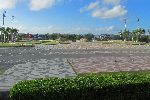 Across
the hall from the memorial is a museum that is primarily dedicated to Che's adult life as a
revolutionary and to the soldiers in Cuba. The museum devotes a lot of space to his life as a guerrilla
fighter, and to the deaths of he and his comrades in Bolivia. It shows a picture of Che disguised as an aging Peruvian diplomat,
ready to depart for Bolivia. There
is a short video that shows him speaking in Cuba, and has Fidel, clearly
moved, reading Che’s last letter from Bolivia. There are details of his childhood, his youth traveling the
continent, his medical studies, and his years of work in Cuba. There is even an early 1950s photo of him setting off on a touring
bike for a pedaling spin around Argentina, with an extra tire slung over
his shoulder. Imagine that,
Che the bicyclist! Information on other aspects of Che's life can
be found at the Museum of the Revolution in Havana.
Across
the hall from the memorial is a museum that is primarily dedicated to Che's adult life as a
revolutionary and to the soldiers in Cuba. The museum devotes a lot of space to his life as a guerrilla
fighter, and to the deaths of he and his comrades in Bolivia. It shows a picture of Che disguised as an aging Peruvian diplomat,
ready to depart for Bolivia. There
is a short video that shows him speaking in Cuba, and has Fidel, clearly
moved, reading Che’s last letter from Bolivia. There are details of his childhood, his youth traveling the
continent, his medical studies, and his years of work in Cuba. There is even an early 1950s photo of him setting off on a touring
bike for a pedaling spin around Argentina, with an extra tire slung over
his shoulder. Imagine that,
Che the bicyclist! Information on other aspects of Che's life can
be found at the Museum of the Revolution in Havana.
![]() Please write if you have questions, comment, criticism, praise or
additional information for us, find a bad link or would like to be added to IBF's mailing list. (Also let
us know how you found this site.)
Please write if you have questions, comment, criticism, praise or
additional information for us, find a bad link or would like to be added to IBF's mailing list. (Also let
us know how you found this site.)
![]() IBF Homepage
IBF Homepage
![]() Cuba
Homepage
Cuba
Homepage ![]() Search
ibike
Search
ibike



